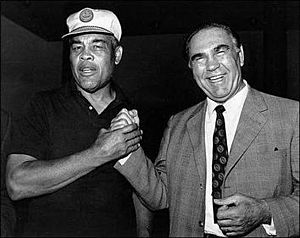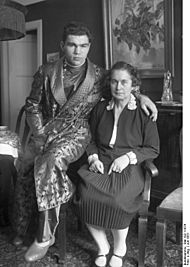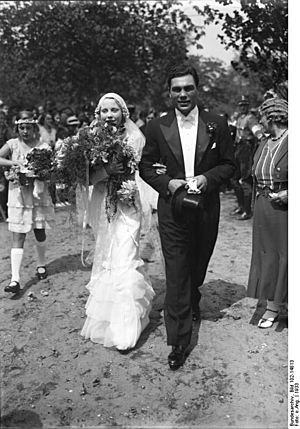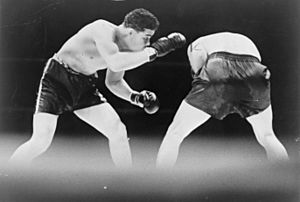Max Schmeling facts for kids
Quick facts for kids Max Schmeling |
||||||||||||||
|---|---|---|---|---|---|---|---|---|---|---|---|---|---|---|

Max Schmeling in March 1930
|
||||||||||||||
| Statistics | ||||||||||||||
| Nickname(s) |
|
|||||||||||||
| Rated at |
|
|||||||||||||
| Height | 6 ft 1 in (1.85 m) | |||||||||||||
| Reach | 76 in (1.93 m) | |||||||||||||
| Born | 28 September 1905 Klein Luckow, Province of Brandenburg, Prussia, German Empire |
|||||||||||||
| Died | 2 February 2005 (aged 99) Wenzendorf, Lower Saxony, Germany |
|||||||||||||
| Stance | Orthodox | |||||||||||||
| Boxing record | ||||||||||||||
| Total fights | 70 | |||||||||||||
| Wins | 56 | |||||||||||||
| Wins by KO | 40 | |||||||||||||
| Losses | 10 | |||||||||||||
| Draws | 4 | |||||||||||||
|
Medal record
|
||||||||||||||
Max Schmeling (born September 28, 1905 – died February 2, 2005) was a famous German boxer. He was the world heavyweight champion from 1930 to 1932. His two big fights against Joe Louis in 1936 and 1938 were huge events around the world. These fights were important because of the countries the boxers came from. Schmeling is also the only boxer to ever win a world heavyweight title because his opponent committed a foul.
Max Schmeling started his professional boxing career in 1924. In 1928, he moved to the United States. He quickly became well-known after beating Johnny Risko. In 1930, he won the heavyweight championship. He won when his opponent, Jack Sharkey, hit him below the belt. This was against the rules, so Sharkey was disqualified.
Schmeling successfully defended his title in 1931. He won against Young Stribling. But in 1932, he lost his title back to Sharkey. Many people thought the judges made the wrong decision. In 1933, Schmeling lost another fight to Max Baer. People started to think he was not as good as he used to be.
Around this time, Adolf Hitler and the Nazi Party took control in Germany. Schmeling never joined the Nazi Party. In the same year, he married a Czech actress named Anny Ondra.
In 1936, Schmeling fought the rising American star Joe Louis. Schmeling won by knocking Louis out. This made Schmeling the top challenger for the world title. However, Louis got to fight the champion instead and won the title in 1937. Schmeling finally got his chance to win back the title in 1938. But Louis won their second fight very quickly.
During World War II, Schmeling served in the German Air Force. He was a paratrooper. After the war, he tried boxing again but retired for good in 1948. Later, he worked for The Coca-Cola Company. Schmeling and Joe Louis became good friends. Their friendship lasted until Louis died in 1981. Max Schmeling passed away in 2005 at the age of 99. He was a sports hero in his home country of Germany. Years after the war, it was learned that Schmeling had risked his life. He saved two Jewish children in 1938. At 99, he was the longest-living heavyweight boxing champion ever.
In 2003, The Ring magazine ranked Schmeling. He was 55th on their list of the 100 greatest punchers of all time.
Contents
Max Schmeling's Life Story
Early Years in Boxing
Max Schmeling was born in Klein Luckow, Germany. His parents were Max Sr. and Amanda Schmeling. He had an older brother, Rudolf, and a younger sister, Edith. Max first saw boxing when his father took him to watch a film. It was a heavyweight championship match. He was very impressed by boxer Jack Dempsey. Young Max decided he wanted to be like him.
He started boxing in amateur fights. By 1924, he won Germany's national amateur title. This was in the light heavyweight division. Soon after, he became a professional boxer. Even though he admired Dempsey's aggressive style, Schmeling developed his own careful way of fighting. He was good at waiting for his opponent to attack. Then he would hit back.
Using this style, he won 17 of his first 23 fights. Thirteen of these wins were by knockout. In 1925, he even got to spar with Jack Dempsey. Dempsey was still the world heavyweight champion. He was touring Europe at the time. Dempsey boxed with the unknown German for two rounds. Schmeling later said Dempsey was very impressed with him.
Schmeling proved Dempsey right on August 24, 1926. He won the German light heavyweight championship. He knocked out Max Diekmann in the first round. Diekmann had beaten Schmeling before. The next year, Schmeling won the European championship. He stopped Fernand Delarge in a fight. This was the first boxing match ever broadcast live in Germany.
He defended both his German and European titles in the same year. In 1928, he defended his European title again. Then he won the German heavyweight championship. He beat Franz Diener on points. After this, he decided to go to the United States. He wanted bigger fights and more money.
Becoming a Star in America
Max Schmeling arrived in New York City in 1928. American boxing fans barely noticed him at first. They thought he was a stiff European fighter. They believed he had only won against unknown German boxers. He didn't get many chances to prove himself. This changed when he started working with American manager Joe Jacobs.
Schmeling's first fight in America was at Madison Square Garden. He knocked out Joe Monte in the eighth round. Monte was not a top boxer. But he had fought against some tough opponents. Schmeling won two more fights. Then he got a chance to fight Johnny Risko. Risko was a big name in boxing, though a bit past his best.
On February 1, 1929, Schmeling knocked Risko down four times. He used his strong right hand. The referee stopped the fight in the ninth round. This was Risko's only loss by technical knockout. The crowd was very surprised and cheered loudly. The Ring magazine called it the 'Fight of the Year.'
The "Low Blow Champion"
Later that year, Schmeling beat Paulino Uzcudun at Yankee Stadium. He won by a decision after 15 rounds. People then saw Schmeling as a top young boxer. The World Heavyweight Champion, Gene Tunney, had just retired. So, promoters set up a fight between Schmeling and Jack Sharkey. The winner would become the new champion.
On June 12, 1930, at Yankee Stadium, they fought. Schmeling was known for starting fights slowly. He was a little behind on points by the fourth round. He was trying to trap Sharkey in a corner. Then Sharkey hit him very hard below the belt. Schmeling fell to the floor. He said he had been fouled. His manager, Joe Jacobs, ran into the ring. The referee then disqualified Sharkey. Schmeling was declared the winner. He became the first boxer to win a world heavyweight championship because of a foul. The New York State Athletic Commission agreed with the decision.
Schmeling was the first European-born boxer to win the heavyweight title in 33 years. He was also the first German to hold this title. But the way he won was a bit embarrassing. People called him the 'low blow champion.' They said he was not a true champion. When he first refused to fight Sharkey again, New York took away his title. But he was still recognized by other boxing groups.
Most of the criticism stopped after Schmeling's first title defense. He beat Young Stribling in 15 rounds. Stribling was a great boxer with 239 wins. To prove he was the true champion, Schmeling agreed to fight Sharkey again. On June 21, 1932, Sharkey won by a close decision. Many people, including former champion Gene Tunney, thought Schmeling should have won. Even though he lost, Schmeling's reputation grew among boxing fans.
Important Fights and World Events
Schmeling then fought Mickey Walker. Walker was a famous boxer who had won titles in two weight classes. Many thought this fight would show who the real heavyweight champion was. Walker was smaller than Schmeling. Walker started strong, but Schmeling took control as the fight went on. After eight rounds, Walker's team stopped the fight. This confirmed Schmeling as one of the world's best heavyweights.
In 1933, Schmeling's image in America began to change. The Nazi Party became very powerful in Germany. Their leader, Adolf Hitler, spread ideas against Jewish people. Many American cities had large Jewish populations. They worried about what this meant for their people. Because Schmeling was German, some saw him as connected to Hitler's plans.
When he was set to fight Max Baer on June 8, 1933, fans saw Schmeling as the 'bad guy.' Baer was not Jewish, but his father was. Baer wore the Star of David on his shorts for the fight. The fight promoter, Jack Dempsey, made this a big deal. The fight became seen as Baer defending his faith against Nazi ideas. Schmeling was affected by the bad publicity. Also, Baer's wild fighting style and fouls threw him off. Schmeling was badly beaten after ten rounds. The referee stopped the fight. This loss, and another one early the next year, made people wonder if Schmeling was still a top boxer.
The Joe Louis Rivalry
Schmeling went back to Germany. He won three of his next four fights. He even got revenge against Steve Hamas. But many American reporters and fans still didn't want to support Schmeling. This was because of the Nazi Party's actions. Articles called him "washed up" or a "Nazi puppet."
In 1936, he was set to fight the undefeated American boxer Joe Louis. This was Schmeling's first fight in America in over two years. He was expected to lose. People thought Louis would easily beat him on his way to the title. But Schmeling was still the number two contender. Before the fight, Schmeling carefully watched videos of Louis's past fights. He found a weakness: Louis would drop his left hand after throwing a jab.
In the ring, Schmeling used this flaw. He hit Louis with his best punch, the right cross, almost every time Louis jabbed. The fight was tough for the first three rounds. But in the fourth, Schmeling's right punch knocked Louis down. This was the first time Louis had ever been knocked down. Louis got up, but he was very dazed. For eight more rounds, Schmeling kept hitting Louis. He often stood close to Louis and landed right hands to his jaw. In the twelfth round, he knocked Louis down again. This time, Louis could not get up. Schmeling had won the biggest upset in sports that year.
Schmeling was now the top challenger for the heavyweight title. He was supposed to fight Jim Braddock for the championship. But the fight was delayed. Some thought the organizers were afraid of bad publicity. They didn't want a German boxer, seen as a Nazi, to win the world title. It was later confirmed that Braddock's managers were talking to Louis's team. The New York Commission ordered Braddock to fight Schmeling. They said any other fight would not be for the championship.
But in February 1937, Schmeling learned that Braddock had signed to fight Louis instead. Schmeling was very angry, but it didn't help. He had to watch as Louis knocked out Braddock and won the championship. Schmeling was very disappointed. He thought he would never get another chance at the title. He fought only one more time in America. Then he returned to Germany.
In Germany, Schmeling was seen as a hero. The Nazi government used him for their propaganda. They said his win over Louis showed German strength. The government held parades and rallies for him. He became friends with Hitler and other powerful figures. He was often in newspapers and films. He kept pushing for a rematch with Louis. Meanwhile, he fought and beat other boxers.
The "Battle of the Century"
In 1938, champion Joe Louis announced he would fight Schmeling for the title. This rematch became a huge international event. Many people were excited, but others protested. They were worried about world tensions. They feared Hitler might take over the championship. All this excitement made it the most anticipated boxing match in a long time.
Louis, who came from a poor background, became a symbol for America. He showed that America was a land of opportunity. Schmeling, with his ties to Hitler, was seen by Americans as a threat to these ideals. When Schmeling walked into Yankee Stadium on June 22, 1938, people threw garbage at him.
Louis started the first round very aggressively. Schmeling tried to counter-punch, but it didn't work. Louis pushed him against the ropes. He hit Schmeling with many quick, hard punches. Schmeling turned his back and grabbed the ropes. He let out a scream that many people remembered years later. Schmeling later said he screamed because he was hit in the kidneys.
Schmeling's legs gave out. The referee pushed Louis away and started counting. Schmeling slowly moved away from the ropes. The referee let him continue. But a few punches later, Schmeling was knocked down again. He was helpless. He got up but fell moments later. The referee stopped the fight.
Many years later, in 1975, Schmeling said something important. He said, "Looking back, I'm almost happy I lost that fight. Just imagine if I would have come back to Germany with a victory. I had nothing to do with the Nazis, but they would have given me a medal. After the war I might have been considered a war criminal."
Schmeling's Later Life

When Schmeling returned to Germany after losing to Joe Louis, the Nazis ignored him. He won both the German and European heavyweight championships. He knocked out Adolf Heuser in the first round. During the Nazi's persecution of Jewish people in Berlin, Schmeling personally saved two Jewish children. He hid them in his apartment.
This was not the first time Schmeling stood up to the Nazis. Hitler had told him he was unhappy. He wanted Schmeling to end his relationship with Joe Jacobs, his Jewish fight promoter. But Schmeling refused to obey Hitler.
During the war, Schmeling was drafted into the Luftwaffe (German Air Force). He was trained as a paratrooper. He fought in the Battle of Crete in May 1941. He was wounded in his right knee by shrapnel. After recovering, he was released from duty because of his injury. In 1944, a rumor spread that he had been killed in action. He later visited American prisoner-of-war camps in Germany. He sometimes tried to help the prisoners.
After the war, Schmeling lived in Hamburg. In 1947, he needed money. He made a small comeback in boxing. He won three of his five fights. He retired for good in October 1948.
In the early 1950s, Schmeling became successful. He farmed mink, chickens, and tobacco. Later, he met with The Coca-Cola Company in Germany. Schmeling became the face of Coca-Cola's return to Germany. Soon, he owned his own bottling plant. He also held an executive position in the company. Schmeling helped bring vending machines to Germany.
He became good friends with Joe Louis. Even though they weren't always close, Schmeling helped Louis financially in his later years. He even paid for Louis's funeral in 1981.
His wife of 54 years, Anny Ondra, died in 1987. In 1992, he was added to the International Boxing Hall of Fame. His autobiography, Max Schmeling: An Autobiography, was published in 1994. He lived his remaining years as a wealthy man and a big boxing fan. He died on February 2, 2005, at 99 years old.
In 2010, a bronze statue of Schmeling was put up in Hollenstedt, Germany.
Max Schmeling's Achievements
- German Light Heavyweight Champion 1926–1928
- European Light Heavyweight Champion 1927–1928
- German Heavyweight Champion 1928
- World Heavyweight Champion 1930–1932
- European Heavyweight Champion 1939–1943
Honorary Titles
- Honorary Resident of the City of Los Angeles
- Honorary Resident of Las Vegas
- Honorary Resident of Klein-Luckow (his hometown)
- Honorary Member of the Austrian Boxing Federation
Images for kids
See also
 In Spanish: Max Schmeling para niños
In Spanish: Max Schmeling para niños
- List of heavyweight boxing champions
- List of European Boxing Union heavyweight champions









